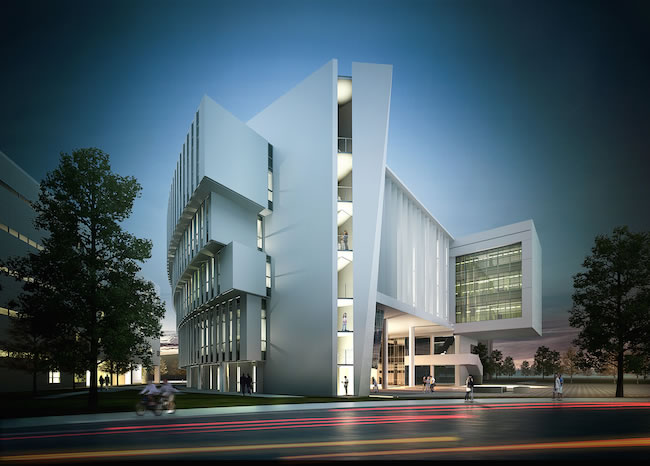Where technology has succeeded in rendering the passing of information democratized, it has too, by way of smart mobile gizmos, made the presence of it essentially ubiquitous. Likewise, as the increased urgency of environmental maladies has made permanent the imperative of sustainability, a subject of news reporting and public discussion, we’re confronted daily with its gloomy repercussions. And so, we look to experts and officials for answers. To provide such answers, Perkins+Will designed Florida International University’s Stempel Complex that will house the Extreme Events Institute, an interdisciplinary research team devoted to the development of hard-nosed, controlled responses to the most dire of natural disasters.

Within the complex lies a a very particular conference room that can be used as a war room for any government institution or partner.
SYNERGY SERIOUSLY
PROJECT
Location Miami, FL
Client Florida International University
Size 121,500 ft 2 Completion June 2014
Program College
of Public Health, Extreme Event Institute, Earth and Environment, College of Social Work
Cost Witheld
TEAM
Contractor Skanska Engineering & Consulting
Walter P. Moore
Consulting Engineers BR+A
Landscaping P+W Landscaping
“It’s not the old-school mentality,” Pat Bosch, principal design architect on the project (and design director of Perkins+Will’s Miami office), says in reference to the traditional university model where certain colleges (e.g., school of business, school of medicine, et al.) have the breadth of their studies compact in one designated building. On the contrary, the interconnectivity between departments housed within the Stempel Complex enhances the fruits of their work. Contributions made by the College of Public Health and Social Work, the College of Earth and Environment, and the College of Medicine are among the lot that brings a composite perspective approach to flourish. Bosch notes the range of individual angles involved, “from the physical cause and effect of earth and environ- ment studies to a lot of the social consequences that occur from that in terms of public health and social work and also from the basic health sciences perspective.”
LIGHTING THE WAY
One of the strongest features of the complex is how conducive the design of the building is to the utilization of daylight. It preserves a satisfying level of comfort and serenity while eliminating strenuous energy consumption. Copious daylight harvested from the high-performance glass invites natural warmth, while the “ripple effect” of the south façade functions as a self-shading structure. The sunlight is sourced from the large courtyard space that the totality of the Stempel Complex encircles, allowing the flow of sunbeams to permeate throughout the transparently open floor plans of each level. “The building almost breathes in a way,” as Bosch puts it, observing the fluidity in which natural warmth moves in and the building’s natural cooling supplants it. “It’s art meets science.”

BUILDING WITH YOUR BRAIN
Perhaps it could be suggested that the most sensible way to inspire smart research is to shelter it with smart building. It’s one thing to devise educational curriculums that elucidate the importance of sustainability as a critical societal investment, but it’s another to do so while exemplifying its implementation in the construction hall in which it’s taught. “We planned and used a lot of software such as Ecotec to modulate and model a lot of the energy consumption during the process of design,” Bosch illustrates. The team also employed a chilled beam system that enables self-regulated cooling while minimizing ductwork, which Bosch notes is particularly handy in typically high-consumption rooms such as laboratories.
AN A FOR ADAPTABILITY
“You don’t duplicate facilities, you make them more flexible and nimble,” decrees Bosch, sharing her team’s guiding design philosophy when it comes to the most suitable conditions for the Stempel Complex’s needs. Thus, many of the spaces that comprise the complex are designed to serve as easily transformable multi-purpose rooms. Training sessions can be conducted, team-based projects can be performed, and, at any particular moment, proper emergency procedures in the wake of any sort of cataclysm. “These rooms also morph into areas where in the case of an extreme event they can have a lot of media housed in there for broadcasting or gathering of information,” Bosch explains. “There is a very particular conference room that can be used as a war room for any government institution or partner.”

High-performance glass invites ample daylight from the large courtyard space into the Stempel Complex, while the building’s natural cooling supplants the resulting warmth.

